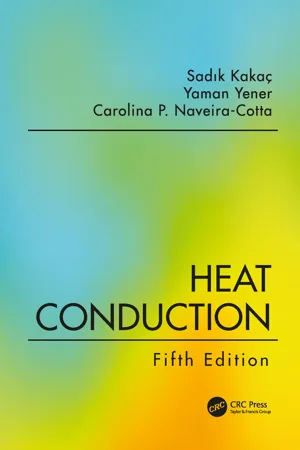Technology & Engineering
Heat
Heat is a form of energy that can be transferred between objects or systems. It is typically generated by the movement of atoms and molecules within a substance. In engineering, heat is a crucial factor in the design and operation of various technologies, such as engines, HVAC systems, and industrial processes.
Written by Perlego with AI-assistance
Related key terms
Related key terms
1 of 4
Related key terms
1 of 3
4 Key excerpts on "Heat"
- eBook - ePub
- Sadık Kakac, Yaman Yener, Carolina P. Naveira-Cotta(Authors)
- 2018(Publication Date)
- CRC Press(Publisher)
1 Foundations of Heat Transfer 1.1 Introductory Remarks Heat transfer is that branch of engineering science which studies the transfer of energy solely as a result of temperature differences. Heat transfer problems confront engineers and researchers in nearly every branch of engineering and science. Although it is generally regarded as most closely related to mechanical engineering, much work in this field has also been done in chemical, nuclear, metallurgical, and electrical engineering, where Heat transfer problems are equally important. It is probably this fundamental and widespread influence that has helped the field of Heat transfer develop as an engineering science. Thermodynamics, another branch of the engineering science, studies Heat and work interactions of a system with its surroundings, and defines Heat as the form of energy that crosses the boundary of a system by virtue of a temperature difference existing between the system and its surroundings. That is, Heat is the energy in transition across the system boundary and temperature difference is the driving potential for its propagation. Since Heat is energy in transit, one should really talk about the transfer or flow of Heat. Heat flow is vectorial in the sense that it is in the direction of a negative temperature gradient, that is, from higher toward lower temperatures. The laws of thermodynamics may be used to predict the gross amount of Heat transferred to or from a system during a process in which the system goes from one thermodynamic state (i.e., mechanical and chemical, as well as thermal equilibrium) to another. In most instances, however, the overriding consideration may be the time period over which the transfer of Heat occurs or, simply, the time rate at which it takes place. The laws of thermodynamics alone are not sufficient to provide such information; neither can they explain the mechanisms of Heat transfer, which are not strictly restricted to equilibrium states - eBook - ePub
Fluid and Thermal Dynamics Answer Bank for Engineers
The Concise Guide with Formulas and Principles for Students and Professionals
- Ethirajan Rathakrishnan(Author)
- 2023(Publication Date)
- BrownWalker Press(Publisher)
Chapter 7
Heat Transfer
7.1Basic Concepts and Definitions
Heat transfer is the science of energy in transit due to a temperature difference.In a Heat transfer process,• Conduction is an energy transfer process from more energetic particles of a substance to the adjacent, less energetic ones as a result of the interaction between the particles.• Convection is the mode of Heat transfer between a solid surface and the adjacent liquid or gas that is in motion.• Radiation is the Heat transfer mode in which the energy is emitted by matter in the form of electromagnetic waves (or photons) as a result of the changes in the electronic configurations of the atoms or molecules.Any physical quantity can be characterized by dimensions . The magnitudes assigned to the dimensions are called units . The law of dimensional homogeneity states that, an analytically derived equation representing a physical phenomenon must be valid for all systems of units.System is an identified quantity of matter or an identified region in space chosen for a study. The region outside the system is called surrounding . The real or imaginary surface that separates the system from its surroundings is called the boundary . A closed system (control mass) consists of a fixed amount of mass (say a gas mass), and no mass can cross its boundary. Mass cannot cross the boundaries of a closed system, but energy can cross the boundaries. Isolated system is a special case of closed system where even energy is not allowed to cross the boundary. An open system (control volume) is a properly selected region in space, which may change its position and mass can enter and leave the region, but the size and shape of the system will remain invariant.Energy can exist in numerous forms, such as chemical, electrical, kinetic, potential, mechanical, thermal, and nuclear, and their sum constitutes the total energy of a system. The total energy of a system per unit mass is termed specific energy . The macroscopic energies are those a system possesses as a whole, with respect to some outside reference frame, such as kinetic energy and potential energy. The microscopic forms of energy are those related to the molecular structure of a system and the degree of the molecular activity, and they are independent of outside reference frames. The sum of all the microscopic forms of energy is called the internal energy of a system. The energy that a system possesses as a result of its motion relative to some reference frame is called the kinetic energy . The potential energy - eBook - ePub
Reliability Technology
Principles and Practice of Failure Prevention in Electronic Systems
- Norman Pascoe(Author)
- 2011(Publication Date)
- Wiley(Publisher)
Chapter 4 Heat Transfer – Theory and Practice Science is built up of facts, as a house is built of stones; but an accumulation of facts is no more a science than a heap of stones is a house. Science and Hypothesis (1950 ch. 9) 4.1 Overview An understanding of the physical mechanisms involved in the transfer of Heat within a material and from one material to another is an essential attribute for the design of reliable electronic hardware. The material contained within this chapter will, hopefully, also help to provide a clearer understanding of the principles of Heat transfer that make such an important contribution to the development of effective reliability growth programmes. In order to generate realistic thermal stresses, and stimulate effective thermal responses within electronic hardware for the purpose of achieving effective qualification, accelerated ageing, and Stress Screening objectives, the essential physics of Heat transfer and thermomechanical ageing must be properly understood. This chapter deals with the basic principles of Heat transfer and temperature measurement for those design, test, and reliability engineers who seek to strengthen their understanding of the influence of cyclic thermomechanical behaviour on product robustness and durability. The thermal management of electronic hardware, and the forced stimulation of cyclic thermomechanical stress reversals within electronic hardware, are treated as two distinctly different topics of concern. There are two fundamentally different concepts associated with the transfer of Heat: 1. Thermodynamics which addresses the amount of Heat that is transferred when a system undergoes a transition from one equilibrium state to another. The time taken for this transition to occur is of no academic consequence. Thermodynamic principles form the basis for the design of thermal chambers used for testing product at high and low temperatures - eBook - ePub
- British Gas(Author)
- 2014(Publication Date)
- Routledge(Publisher)
Heat is energy in transition under the motive force of a temperature difference, and the study of Heat transfer deals with the rate at which such energy is transferred. In thermodynamic analyses ideal processes can be conceived during which Heat is transferred by virtue of an infinitesimally small temperature difference, without regard to time as a limiting factor. In actual processes some of the available temperature drop, which might be used for the production of work, must be sacrificed to ensure that the required quantity of Heat is transferred in a reasonable time across a surface of practicable size. Two broad types of problem are frequently of interest to engineers: the first, met in the design of boilers, Heat exchangers and other plant, is concerned with the promotion of the required rate of Heat transfer with the minimum possible surface area and temperature difference. The other is concerned with the prevention of Heat transfer, i.e. with thermal insulation.Before considering the various mechanisms by which Heat is transferred it is necessary to understand the different ways in which substances are made up from the constituent atoms or molecules. The phases of pure substances (solids, liquids and gases) are associated very closely with the internal energy of the substance.For the same substance in its various phases, the various thermal properties — specific Heat capacity, conductivity etc — will have values of different orders of magnitude. The specific Heat capacity of a solid is generally very low, for a liquid it is comparatively high, while a gas usually has an intermediate value. In addition, any change of phase will involve a large amount of energy, often termed latent Heat (fusion, vaporisation or sublimation) as shown in Figure 5.1 for the Heating of liquid water to steam. Therefore, whenever a body is absorbing or losing Heat, special consideration must be given as to whether the change is one of sensible Heat, latent Heat, or a combination of the two.5.1.1 Mechan isms of Heat Transfer
There are three modes of Heat transfer: conduction, convection and radiation.Fig. 5.1 Sensible and latent Heating of water
Index pages curate the most relevant extracts from our library of academic textbooks. They’ve been created using an in-house natural language model (NLM), each adding context and meaning to key research topics.
Explore more topic indexes
Explore more topic indexes
1 of 6
Explore more topic indexes
1 of 4



